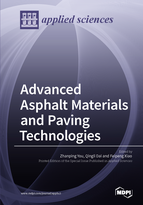Advanced Asphalt Materials and Paving Technologies
A special issue of Applied Sciences (ISSN 2076-3417). This special issue belongs to the section "Mechanical Engineering".
Deadline for manuscript submissions: closed (30 June 2017) | Viewed by 161383
Special Issue Editors
Interests: design, construction, and maintenance of pavements; micromechanics for road materials; discrete and finite element modeling techniques; construction materials: asphalt, aggregate; alternative and recycled materials for civil engineering
Special Issues, Collections and Topics in MDPI journals
Interests: advanced characterization; simulation and testing of civil engineering materials; smart technologies for transportation materials and resilient structures; sustainable and energy-efficient structural materials
Special Issues, Collections and Topics in MDPI journals
Interests: asphalt materials and pavements; sustainability and reuse/recycling of infrastructure materials; model and design of pavement materials; nanotechnology in civil engineering materials; and low energy pavement technology
Special Issue Information
Dear Colleagues,
There has been quite a bit of research progress in the area of asphalt materials and paving technologies in the past decade. These include the use of warm mix asphalt technologies, rubber asphalt, bio-mass derived asphalt, nano materials application, as well as the application of mechanistic-empirical design. The asphalt pavement industry has made extensive efforts to develop and promote new pavement materials and structures for constructing and maintaining sustainable pavement. Pavement materials, which can extend durability, cut costs, reduce neat material usage, and lower environmental impacts, are desirable for such purposes. Modified asphaltic materials have been well developed over the past few decades. Meanwhile, some new design ideas that differ from traditional pavement structures have shown noticeable benefits in terms of pavement durability or cost. With all these development, a collection of the advances in the area of advanced asphalt materials and paving technologies will be necessary for the industry, researchers, government agencies, and other stakeholders.
We invite authors to contribute original research articles, as well as review articles, that will contribute to the area in asphalt materials and paving technologies. The advanced materials shall conform to the goal of applied science, and also promote new technology, low cost, high durability, environmental friendliness, and effective resource usage.
Potential topics include, but are not limited to:
- Advanced asphalt materials such as polymer modified asphalt, rubber asphalt, bio-asphalt
- Advanced technologies such as warm mix asphalt, cold mix asphalt
- Innovative pavement or material design protocols
- Recycling materials for pavement purposes
- Advanced asphalt pavement construction and maintenance strategies
Prof. Zhanping You
Prof. Dr. Feipeng Xiao
Prof. Dr. Qingli (Barbara) Dai
Guest Editor
Manuscript Submission Information
Manuscripts should be submitted online at www.mdpi.com by registering and logging in to this website. Once you are registered, click here to go to the submission form. Manuscripts can be submitted until the deadline. All submissions that pass pre-check are peer-reviewed. Accepted papers will be published continuously in the journal (as soon as accepted) and will be listed together on the special issue website. Research articles, review articles as well as short communications are invited. For planned papers, a title and short abstract (about 100 words) can be sent to the Editorial Office for announcement on this website.
Submitted manuscripts should not have been published previously, nor be under consideration for publication elsewhere (except conference proceedings papers). All manuscripts are thoroughly refereed through a single-blind peer-review process. A guide for authors and other relevant information for submission of manuscripts is available on the Instructions for Authors page. Applied Sciences is an international peer-reviewed open access semimonthly journal published by MDPI.
Please visit the Instructions for Authors page before submitting a manuscript. The Article Processing Charge (APC) for publication in this open access journal is 2400 CHF (Swiss Francs). Submitted papers should be well formatted and use good English. Authors may use MDPI's English editing service prior to publication or during author revisions.








